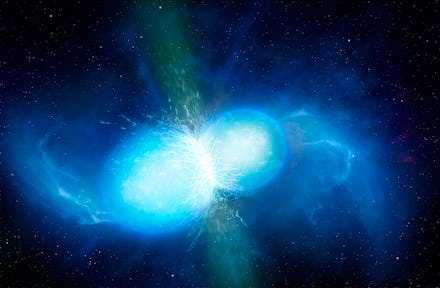How two weird stars could help researchers solve the mysteries of life

Researchers led by the University of East Anglia have discovered a pair of asymmetrical neutron stars that have the potential to answer some of life's biggest questions. Using the world's largest radio telescope, located at Arecibo Observatory in Puerto Rico, the team of scientists detected lighthouse-like beams of radiation coming from the north and south poles of a neutron star. Shortly after, they realized it was orbiting yet another neutron star with a very different mass, making this the "most asymmetric merging system reported so far," according to the team's report published on July 8 in Nature.
Although the research team isn't 100 percent sure where this new discovery will lead, they're hopeful that the nature of these stars, the matter they contain, and their possible collision could provide insight into longstanding questions about the universe, such as how gravity works, how to measure how fast the universe is expanding, and where heavy elements like gold came from.
Neutron stars are dead stars that come into existence when, after a star has run out of fuel and its core collapsed, gravity crushes the remaining protons and electrons together until they become densely packed neutrons. Neutron stars can tell us a lot about gravitational waves, ripples in space-time first theorized by Albert Einstein, which can also help us figure out how exactly gravity works in reality, not just in theory.
The researchers, led by physicist Robert Ferdman, first discovered the pair of neutron stars back in 2012. Their new study noted the team's observations of the stars' masses and a calculated prediction that the stars might collide and merge together in about 470 million years — just a sliver of time compared to the presumed age of the universe.
The two stars, part of a system called PSR J1913+1102, are special in that their masses are significantly different from each other; the stars are 1.62 and 1.27 times the mass of our sun. They're reminiscent of another pair of neutron stars that collided in 2017, an event called GW170817, which sent scientists into a tizzy over the resulting gravitational ripples.
"Back in 2017, scientists at LIGO/Virgo first detected the merger of two neutron stars," Ferdman explained in a press release. "The event caused gravitational-wave ripples through the fabric of space-time, as predicted by Albert Einstein over a century ago. It confirmed that the phenomenon of short gamma-ray bursts was due to the merger of two neutron stars."
This event contributed greatly to gravitational wave astronomy, he continued, which gives the team high hopes that PSR J1913+1102 will also reveal more about gravitational waves and the speed at which the universe is currently expanding. This expansion is called the Hubble Constant, and has theoretically been happening since the universe began in the Big Bang.
Studying the dual stars and learning more about how they collide could also provide answers to how heavy elements, like gold, came to exist. During the neutron star collision of 2017, the LIGO/Virgo team was surprised to find an extreme amount of matter scattering as a result of the merge. This matter may have scattered and seeded planets with elements that eventually resulted in the origins of life.
It's no wonder Ferdman and his team are excited to see where this pair of neutron stars, as well as others yet to be discovered, will take us next. They plan to continue their research and look further into whether studying these systems can confirm or disprove any theories in Hubble Constant research and "understand in more detail how the Universe evolved."